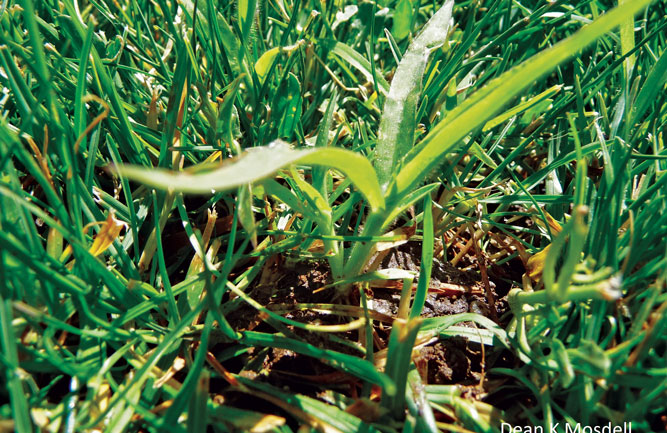Clark Talks Turf: Battling goosegrass
Scott McElroy, Ph.D., is a turfgrass weed scientist at Auburn University. Scott conducts numerous field and laboratory experiments each year to develop weed control strategies for golf courses. You may reach Scott at jsm0010@auburn.edu for more information.
Q: How widespread is goosegrass on golf courses in your region?
You’ll find it on nearly all golf courses, regardless of budget. Once goosegrass is present on a green it quickly spreads to all greens. It usually gets a foothold in the green surround and spreads to the greens from there because it can tolerate close mowing heights without a problem.
Goosegrass is becoming more widely distributed throughout the country, possibly because summers are becoming hotter and longer.
Q: What do you recommend for postemergent goosegrass control on a bermudagrass green?
Currently, Revolver (foramsulfuron, Bayer) is the only herbicide labelled for postemergent goosegrass (Elusine indica) control on bermudagrass putting greens. Research has shown that application at 0.4 fl. oz. per 1,000 sq. ft. every two to three weeks — with a total of three applications — works well to control goosegrass. The key is to make the first application early in the season while the goosegrass is small.
It’s important that the golf industry find additional herbicides for postemergent goosegrass control, because in my opinion the probability of goosegrass developing resistance to Revolver is high. Combinations of Revolver plus Dismiss (sulfentrazone, FMC) in field research are effective, but Dismiss is not labeled for use on bermudagrass putting greens.
Illoxan (diclofop-methyl, Bayer) is no longer offered for sale, but superintendents can use existing stocks for postemergent goosegrass control on putting greens.
For season-long control of goosegrass on bermudagrass putting greens, I recommend split applications of Andersons Goosegrass and Crabgrass Control (bensulide and oxadiazon, Andersons) according to label directions, followed by Revolver applied for postemergent control as described above.
Q: What do you recommend for postemergent goosegrass control in bermudagrass green surrounds?
A tank mix of Revolver plus Dismiss is effective. I have seen excellent goosegrass control in bermudagrass green surrounds with Pylex (topramezone, BASF). Pylex functions as an early postemergent herbicide with some preemergent activity, so apply when the goosegrass is small. Be aware that Pylex causes whitening of the bermudagrass that lasts two to three weeks, so use lower rates. You can reduce the whitening by adding a chelated iron product to the Pylex. One application of Pylex won’t damage bermudagrass permanently, but more than one application can reduce bermudagrass density.
For preemergent goosegrass control in bermudagrass surrounds, Ronstar (oxadiazon, Bayer) and Specticle (indaziflam, Bayer) are effective. Don’t let any of the Specticle reach the green because damage will occur.
Q: What do you recommend for postemergent goosegrass control on creeping bentgrass greens?
To my knowledge there are no postemergent herbicides labelled for goosegrass control on creeping bentgrass greens.
The best option for creeping bentgrass greens is to split applications of Andersons Goosegrass and Crabgrass Control (bensulide and oxadiazon, Andersons) according to label directions.
My observation is that the more thatch that is present, the more goosegrass that is present. Cultural practices that lead to a firm putting surface and controlling thatch lead to less goosegrass.
Q: What do you recommend for postemergent goosegrass control on bermudagrass tees and fairways?
Dismiss or Revolver are good options on tees. In spring, an application of Ronstar as a preemergent reduces problems later in the season.
Goosegrass on fairways is not as big a problem because there is a wide range of preemergent herbicides available to control goosegrass. So, scout on a regular basis and control goosegrass postemergently as it is observed.
Q: Is there anything else you would like to add?
Herbicide-resistant goosegrass has been documented on several golf courses. To reduce the chances of herbicide-resistant goosegrass developing, use both preemergent and postemergent herbicides to control goosegrass. Use multiple modes of action when selecting both preemergent and postemergent herbicides.










